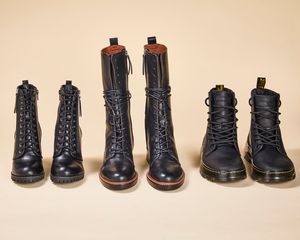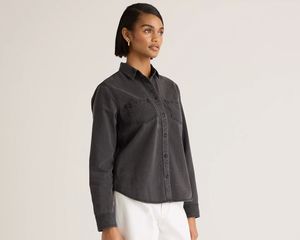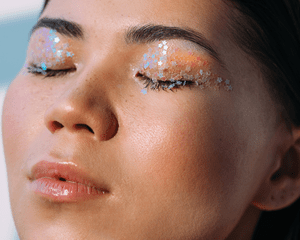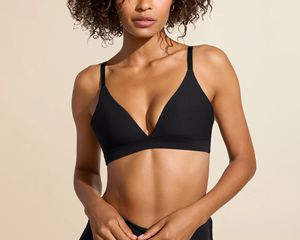Targeted ads feel as integral to the modern experience as asking your friends for a phone charger or being ghosted by a Bumble match. Google something twice and suddenly, the entire internet seems to conspire to get you to buy it.
For me, over the last several months, that something has been the Nap Dress.
Ask any New York City femme of a certain social scene what the most ubiquitous fashion statements of the last few years have been, and the Nap Dress will surely be wedged somewhere between Telfar Shopping Bags and New Balance sneakers on their list. Launched by the brand Hill House Home in 2019, the smocked-bodice dress was perfectly described by The Cut’s Matthew Schneier as “somehow both a little modest and a little sexy.” The signature variation, the Ellie Nap Dress, features an A-line skirt that grazes the calves; the waist is nipped, the straps are ruffled, and the neckline is low enough to frame a statement necklace but high enough to wear to your cousin’s wedding without comments from your grandma.
To be clear, it’s not by chance that ads for the Nap Dress seem to pop up every time I open a browser: I’ve actively sought it out on more than one occasion, checking out the patterns available in my size or variations that best suit my taste. (At the moment, I’m admittedly kind of crushing on the Ophelia, which features puffy, quarter-length sleeves and a lower scooped neckline.)
But, dear reader, I feel weird about it.
If there’s one defining feature of the Nap Dress, it’s that it is unequivocally and indisputably feminine. Ladylike, even. Which is not inherently a bad thing, by any means. As a beauty editor and writer, it’s quite literally part of my job to uplift interests that are viewed as “feminine” and/or associated with women, which are frequently devalued in our culture. And as anyone who knows me can attest, my personal style is pretty high femme.
:max_bytes(200000):strip_icc()/embed4-474ec860eb124b93861c3a4300ab641b.jpg)
Stocksy / Design by Tiana Crispino
In 2022, however, dressing in a sort of moderately yassified Little House on the Prairie aesthetic feels like more than just slipping on something that’s both dressy and comfy. Which begs the question: Is the nap dress just a trendy statement piece, or could it be a tacit acceptance of the pendulum swinging backward?
In June, the United States Supreme Court overturned Roe v. Wade, eliminating the constitutional right to an abortion. Membership in the right-wing extremist group the Proud Boys saw an uptick in 2021. And I’m certainly not the first person to note the unbearable whiteness of the cottagecore aesthetic, which can, inadvertently or not, romanticize a “simpler” time in which women were in the home and Indigenous people were being violently forced off their lands.
Fashion history is replete with examples of clothing directly mirroring the sociopolitical and economic realities of the day. As Byrdie writer Nandini Maharaj noted, shoulder pads became a staple of women’s clothing in the 1940s as women entered the wartime workforce. By the 1950s, as women returned to the home, Christian Dior’s New Look—characterized by nipped waists and full skirts—set the standard for the fashionable look of the day.
The transition from the “masculine” 1940s to the “feminine” 1950s was at the top of my mind as I sat down to chat with Sara Hume, a professor and curator at Kent State University who focuses on the history of dress, about the Nap Dress. Hume, however, offered a different perspective.
“Actually, the reaction I had to it was less that it’s conservative and more that it’s infantilizing,” says Hume. “It’s like a child’s dress that’s being repurposed for adults. The smocking, the ruffles, the patterns, and the colors and such.” Noting that the style reminds her of “idealized childhood feminine styles” of the 1930s, Hume points out that performing gender in childhood is a relatively modern idea—emerging in the early to mid-20th century—but is in full force today (“like making sure we market little girls with ruffles on their head even when they don’t have any hair”).
Stocksy / Design by Tiana Crispino
During our conversation, I began to think of the dress through another lens: nostalgia. Much like those busting out their skinny jeans and hair jewels as part of the Y2K Renaissance, many Nap Dress wearers are, consciously or unconsciously, harkening back to a time before student loans and a massive global health crisis, when their greatest concern was whether or not they’d get an American Girl Doll for their birthday.
That’s not to say that looking at the Nap Dress through the lens of growing political conservatism doesn’t apply though. “It’s conservative in the sense that it is nostalgic,” says Hume. “It harkens back to some sort of idealized past and it’s hyperfeminine. And femininity is a thing that conservatives are afraid is at stake; that there’s an adoption of masculine traits and a loss of idealized femininity.” Indeed, during the politically conservative 1980s—the decade that gave us Ronald Reagan, Margaret Thatcher, and trickle-down economics—Laura Ashley’s floral, puff-sleeve dresses (arguably the Nap Dress’s most direct ancestor) were all the rage.
However, much like how the Y2K trend and cottagecore seem to co-exist in peace, so too did the Victorian-inspired fashions by designers such as Ashley and Jessica McClintock and the more daring fashions that define many of our mental images of the 1980s. Overall, “fashion was really pushing a lot of boundaries and [overall] was not at all ultrafeminine” in the ’80s, says Hume.
:max_bytes(200000):strip_icc()/embed5-03ab68f40ad54c458028572542fc72f3.jpg)
Stocksy / Design by Tiana Crispino
I left my chat with Hume looking at the Nap Dress from a new perspective. Ultimately, while it is feminine, the dress—which, as Hume notes, is “quite revealing” in many of its iterations—isn’t exactly conservative clothing. And it’s not like most Nap Dress devotees are exclusively wearing dresses with “Mommy and Me” energy; a quick perusal of Instagram will show them in blazers and crop tops too.
Perhaps a great deal of the popularity of the nap dress can be chalked up to something significantly more mundane: After nearly two years of living in athleisure, folks don’t want to sacrifice ease of movement for style, but they do want to feel like they’ve shed their cocoon of sweatpants and emerged as beautiful, comfortable butterflies. Add in a swelteringly hot summer, and you’ve got a pretty great moment for a cotton dress to take center stage. And the impact of social media certainly plays a role; see enough gorgeous, gorgeous girls in Nap Dresses eating gelato on the Amalfi coast, and you’re bound to eventually give in to the aspirational siren’s song.
While it's important to look at our choices through a critical lens—related to the media we consume, the way we date, or yes, the clothes we wear—sometimes identifying why we’re drawn to a certain style or aesthetic is complicated.
Maybe this time, I can just add to cart.
:max_bytes(150000):strip_icc()/BYR_2022Q3DI_LandingPage-RECIRC-70c93149aa184d9a9f5c8e4b07a89758.jpg)
:max_bytes(150000):strip_icc()/recic-0585f86cb6bf420eaeb9ae44e3e70664.jpg)
:max_bytes(150000):strip_icc()/recirc3-413219801b88419a9902bac1e3bed083.jpg)
:max_bytes(150000):strip_icc()/recirc3-cd665047c290482096bb37bd73b633ef.jpg)
:max_bytes(150000):strip_icc()/recirc41-0e24d509e7c54ea28b32923cd9e095bf.jpg)
:max_bytes(200000):strip_icc()/SF2-e3577b4e33ec42fc984c59f33b136100.jpg)
:max_bytes(150000):strip_icc()/fullbleed2-0bc9c14396a441f98ea9604ae0bbae25.jpg)




